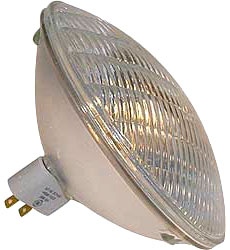|
Socapex
Socapex is a brand of electrical connectors, known in the entertainment industry primarily for their 19-pin electrical connectors, commonly known as Socapex connectors, and used in film, television, and stage lighting to terminate the ends of a multicable. They are wired with six hot/live pins, six neutral pins, six ground/earth pins, and a final central pin used to aid alignment of the male end of the connector with a female receptacle. The Socapex was first created by a company called Socapex in 1961, which later on became Amphenol Socapex. "Socapex" became a brand name owned by Amphenol Socapex, the term "Soca" is now often applied to similar off-brand connectors as a genericized trademark. "Breakouts" are often used to connect fixtures to the cable. The breakout consists of a malSocapexconnector with six "tails" with female connectors such as parallel blade receptacle, stage pin connector, IEC 60309 16 A, NEMA L5-20P & L6-20P 'twist-lock', BS 546 15 A, PowerCon or Schu ... [...More Info...] [...Related Items...] OR: [Wikipedia] [Google] [Baidu] |
Stage Pin Connector
A stage pin connector, also known as a grounded stage pin (GSP), grounded pin connector (GPC) or theater paddle (TP), is a standard cable type for theatrical lighting in North America and in many countries in the theatre world.Richard Cadena, ''Electricity for the Entertainment Electrician & Technician'', Focal Press, 2009 (). Uses Stage pin connectors are generally used for conducting dimmed power from a dimmer to stage lighting instruments, although occasionally they can power other equipment. Construction The first stage pin connectors had two cylindrical pins, one for line (hot) and one for neutral, arranged symmetrically in a rectangular housing. The housing was milled from a solid block of fiberglass or bakelite which may have been impregnated with asbestos for fire resistance, with a screw-on cover. Later connectors (including those currently manufactured) use molded plastic or machined phenolic resin laminate housings . These two-pin connectors were not polarized ... [...More Info...] [...Related Items...] OR: [Wikipedia] [Google] [Baidu] |
Stage Lighting
Stage lighting is the craft of lighting as it applies to the production of theater, dance, opera, and other performance arts. Stage Lighting Design Principle and Process Several different types of stage lighting instruments are used in this discipline. theatrecrafts' Types of Lanterns. In addition to basic lighting, modern stage lighting can also include special effects, such as Laser lighting display, lasers and fog machines. People who work on stage lighting are commonly referred to as lighting technicians or lighting designers. The equipment used for stage lighting (e.g. cabling, Salt water dimmer, dimmers, lighting instruments, contro ... [...More Info...] [...Related Items...] OR: [Wikipedia] [Google] [Baidu] |
Multicable
In stage lighting, Stage Lighting Design Principle and Process a multicable (otherwise known as multi-core cable or mult) is a type of heavy-duty electrical cable used in theaters to power lights. The basic construction involves a bundle of individual conductors surrounded by a single outer jacket. Whereas single cables only have three conductors, multicable has ten or more. They are configured to run in six or eight-circuit varieties. Typically, both ends of multicable have a specific connector known as a Socapex, Socapex Connector. Technicians then combine the cables with break-outs and break-ins, which essentially are an octopus-like adapter with one Socapex end and six to eight [...More Info...] [...Related Items...] OR: [Wikipedia] [Google] [Baidu] |
Genericized Trademark
A generic trademark, also known as a genericized trademark or proprietary eponym, is a trademark or brand name that, because of its popularity or significance, has become the generic term for, or synonymous with, a general class of products or services, usually against the intentions of the trademark's owner. A trademark is prone to genericization, or "genericide", when a brand name acquires substantial market dominance or mind share, becoming so widely used for similar products or services that it is no longer associated with the trademark owner, e.g., linoleum, bubble wrap, thermos, and aspirin. A trademark thus popularized is at risk of being challenged or revoked, unless the trademark owner works sufficiently to correct and prevent such broad use. Trademark owners can inadvertently contribute to genericization by failing to provide an alternative generic name for their product or service or using the trademark in similar fashion to generic terms. In one example, the Oti ... [...More Info...] [...Related Items...] OR: [Wikipedia] [Google] [Baidu] |
NEMA Connector
NEMA connectors are AC power plugs and sockets, power plugs and sockets used for alternating current, AC mains electricity in North America and other countries that use the standards set by the US National Electrical Manufacturers Association. NEMA wiring devices are made in electric current, current ratings from 15 to 60 amperes (A), with voltage ratings from 125 to 600 volts (V). Different combinations of contact blade widths, shapes, orientations, and dimensions create non-interchangeable connectors that are unique for each combination of voltage, electric current carrying capacity, and Ground (electricity), grounding system. NEMA 1-15P (two-pole, no ground) and NEMA 5-15P (two-pole with ground pin) plugs are used on common domestic electrical equipment, and NEMA 5-15R is the standard 15-ampere electric receptacle (outlet) found in the United States, and under relevant national standards, in Canada (Canadian Electrical Code, CSA C22.2 No. 42), Mexico (-J-163-ANCE) and Japan ... [...More Info...] [...Related Items...] OR: [Wikipedia] [Google] [Baidu] |
IEC 60309
IEC 60309 (formerly IEC 309 and IECEE, CEE 17, also published by European Committee for Electrotechnical Standardization, CENELEC as EN 60309) is a series of international standards from the International Electrotechnical Commission (IEC) for "plugs, socket-outlets and couplers for industrial purposes". They are also referred to as "pin & sleeve" connectors in North America or as "CeeForm" connectors in the entertainment industry. The maximum voltage allowed by the standard is direct current, DC or alternating current, AC; the maximum Current (electricity), current, ; and the maximum frequency, . The ambient temperature range is to . There is a range of plugs and sockets of different sizes with differing numbers of pins, depending on the current supplied and number of phases accommodated. Connectors generally are specified by the voltage and current ratings, general configuration (number of pins), and rotational alignment ("keying"). The fittings are popular in open-a ... [...More Info...] [...Related Items...] OR: [Wikipedia] [Google] [Baidu] |
BS 546
Plugs and sockets for electrical appliances not hardwired to mains electricity originated in the United Kingdom in the 1870s and were initially two-pin designs. These were usually sold as a mating pair, but gradually de facto and then official standards arose to enable the interchange of compatible devices. British standards have proliferated throughout large parts of the former British Empire. BS 1363, ''13 A plugs socket-outlets adaptors and connection units'' is a British Standard which specifies the most common type of single-phase AC power plugs and sockets that are used in the United Kingdom. Distinctive characteristics of the system are shutters on the neutral and (see below) socket holes, and a fuse in the plug. It has been adopted in many former British colonies and protectorates. BS 1363 was introduced in 1947 as one of the new standards for electrical wiring in the United Kingdom used for post-war reconstruction. The plug and socket replaced the BS ... [...More Info...] [...Related Items...] OR: [Wikipedia] [Google] [Baidu] |
PowerCon
powerCON is an electrical electrical connector manufactured by Neutrik for connecting mains power to equipment in confined spaces. It resembles and functions similarly to the Speakon connector: the line connector is inserted into the chassis connector and then twisted to establish contact and lock. Both the line and chassis connectors remain fully insulated even when disconnected. The original and most common version of the powerCON is rated at . It is available in two deliberately incompatible variants to prevent the connection of two mains supplies. The connector is blue and intended for power sources (with power flowing from a blue-ended cable into a chassis socket), while the connector is grey and used for power drains (with power flowing from a chassis socket into a grey-ended cable). Couplers incorporating one chassis socket of each type are available to extend cables. Later, in December 2013, Neutrik introduced a larger version of the powerCON. Unlike the version, t ... [...More Info...] [...Related Items...] OR: [Wikipedia] [Google] [Baidu] |
Schuko
Schuko () or type F, is a connector (plug/socket) system used in much (but not all) of Europe. It is a registered trademark referring to a system of AC power plugs and sockets that is defined as "IECEE/CEE, CEE7/3" (sockets) and "CEE7/4" (plugs). A Schuko plug features two round pins of diameter ( long, centres apart) for the line and neutral contacts, plus two flat contact areas on the top and bottom side of the plug for protective earth (ground (electricity), ground). The socket (which is often, in error, also referred to as CEE7/4) has a predominantly circular recess which is deep with two symmetrical round apertures and two earthing clips on the sides of the socket positioned to ensure that the earth is always engaged before live pin contact is made. Schuko plugs and sockets are symmetric AC connectors. They can be mated in two ways, therefore line can be connected to either pin of the appliance plug. As with most types of European sockets, Schuko sockets can accept Europ ... [...More Info...] [...Related Items...] OR: [Wikipedia] [Google] [Baidu] |
Parabolic Aluminized Reflector Light
A parabolic aluminized reflector lamp (PAR lamp or simply PAR) is a type of electric lamp that is widely used in commercial, residential, and transportation illumination. It produces a highly directional beam. Usage includes theatrical lighting, locomotive headlamps, aircraft landing lights, and residential and commercial recessed lights ("cans" in the United States). Many PAR lamps are of the sealed beam variety, with a parabolic reflector, one or more filaments, and a glass or plastic lens sealed permanently together as a unit. Originally introduced for road vehicle headlamp service, sealed beams have since been applied elsewhere. Halogen sealed beam lamps incorporate a halogen lamp within a quartz or hard glass envelope. Construction A PAR lamp consists of a light source, with lens and a parabolic reflector with a smooth aluminium surface determining the spread of the beam. The most common sealed beam type combines these three elements into an integral unit. The light ... [...More Info...] [...Related Items...] OR: [Wikipedia] [Google] [Baidu] |








